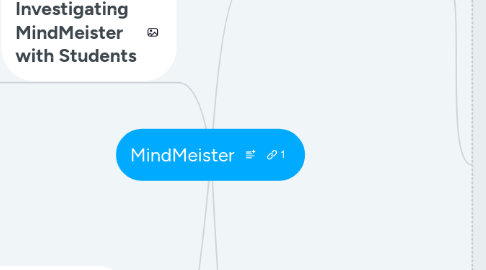
1. Investigating MindMeister with Students
1.1. Course: Design and Drawing for Engineering (DDE)
1.2. Unit: Introduction to The Design Process
1.3. Investigation: Students will learn about the Design Process and how important identifying the problem, brainstorming, and researching solutions can be in the process instead of simply jumping to selecting an approach and building a model to test. I think that this tool would provide them with an opportunity to more dynamically and visually document the beginning steps of the Design Process; including,
1.3.1. Outlining their problem in a very clear, complete, and concise manner
1.3.2. Adding research including links, notes, and images
1.3.3. Listing and describing their brainstorming ideas
1.3.4. Comparing and evaluating any possible solutions they develop
1.3.5. Drawing connections between the problem, the research, and the possible solutions in order to easily evaluate their work
1.4. Advantages: I think that utilizing this tool will assist students in planning and collaborating during the beginning stages of the design process all while increasing productivity, creativity, and engagement.
2. Using MindMeister to promote empowered student learning
2.1. I think that over time the continual use of this tool in the DDE classroom would help to empower students in the design process. When introducing the concept of the design process I would include more detailed direction, more direct problem descriptions, and more support. As students move through developing their skills around the design process and onto other problems to solve, I would leave the problems more open ended, with less detail and direction. This would provide students with the opportunity to explore the problem more from a inquiry based perspective, where they need to set their learning goals and continually evaluate the steps they are taking in their learning process in order to reach their goals.
3. Modeling MindMeister for Colleagues
3.1. Presenting to Colleagues: Once I have explored this tool with my students, evaluated that is it an effective tool for this process, and my students are confidentially directing their own design process with the assistance of the tool, I would like to share the experience.
3.2. Format: I would like to have students who are utilizing the tools provide a quick overview of the activities they are working by informally presenting their MindMeister’s
3.3. Focus: I would like the students who are presenting to focus on productivity, tool capability, collaboration, and ease of use, in addition to their design process content.
3.4. Additionally: I would include other examples of how MindMeister can be utilized in the classroom through the public maps search on their website, and I would discuss the ISTE Standards for Educators that I have met by implementing the utilization of this tool into this learning process.
3.4.1. "Student Learning/ Technological influences" Example
3.4.2. "Global Warming PBL Project Tasks & Responsibilities" Example
4. Connection to ISTE Standards
4.1. Student Standards
4.1.1. Empowered Learner - 1a - Students articulate and set personal learning goals, develop strategies leveraging technology to achieve them and reflect on the learning process itself to improve learning outcomes.
4.1.2. Empowered Learner - 1b - Students build networks and customize their learning environments in ways that support the learning process.
4.1.3. Digital Citizen - 2b - Students engage in positive, safe, legal and ethical behavior when using technology, including social interactions online or when using networked devices.
4.1.4. Knowledge Constructor - 3c - Students curate information from digital resources using a variety of tools and methods to create collections of artifacts that demonstrate meaningful connections or conclusions.
4.1.5. Knowledge Constructor - 3d - Students build knowledge by actively exploring real-world issues and problems, developing ideas and theories and pursuing answers and solutions.
4.1.6. Innovative Designer - 4a - Students know and use a deliberate design process for generating ideas, testing theories, creating innovative artifacts or solving authentic problems.
4.1.7. Computational Thinker - 5c - Students break problems into component parts, extract key information, and develop descriptive models to understand complex systems or facilitate problem-solving.
4.1.8. Creative Communicator - 6c - Students communicate complex ideas clearly and effectively by creating or using a variety of digital objects such as visualizations, models or simulations.
4.1.9. Global Collaborator - 7b - Students use collaborative technologies to work with others, including peers, experts or community members, to examine issues and problems from multiple viewpoints.
4.1.10. Global Collaborator - 7c - Students contribute constructively to project teams, assuming various roles and responsibilities to work effectively toward a common goal.
4.2. Educator Standards
4.2.1. Leader - 2c - Model for colleagues the identification, exploration, evaluation, curation and adoption of new digital resources and tools for learning.
4.2.2. Collaborator - 4b - Collaborate and co-learn with students to discover and use new digital resources and diagnose and troubleshoot technology issues.
4.2.3. Collaborator - 4c - Use collaborative tools to expand students' authentic, real-world learning experiences by engaging virtually with experts, teams and students, locally and globally.
4.2.4. Designer - 5b - Design authentic learning activities that align with content area standards and use digital tools and resources to maximize active, deep learning.
4.2.5. Designer - 5c - Explore and apply instructional design principles to create innovative digital learning environments that engage and support learning.
4.2.6. Facilitator - 6c - Create learning opportunities that challenge students to use a design process and computational thinking to innovate and solve problems.
4.2.7. Facilitator - 6d - Model and nurture creativity and creative expression to communicate ideas, knowledge or connections.

